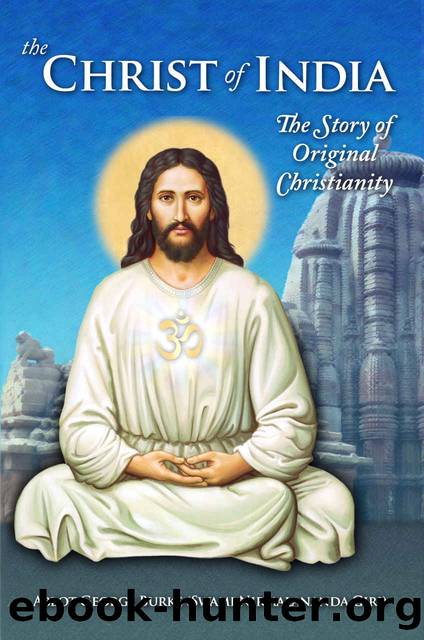The Christ of India: The Story of Original Christianity by Abbot George Burke (Swami Nirmalananda Giri)

Author:Abbot George Burke (Swami Nirmalananda Giri) [Burke (Swami Nirmalananda Giri), Abbot George]
Language: eng
Format: azw3
Tags: Indian philosophy, philosophy, India, christianity, spirituality, hinduism
Publisher: Light of the Spirit Press
Published: 2016-07-21T16:00:00+00:00
This is the Complete; That is the Complete.
The Complete has come out of the Complete.
If we take the Complete away from the Complete,
Only the Complete remains.
Let us say it another way: the Absolute is the Totality; the Relative is the Totality. The Relative has emanated from the Absolute. Yet if we take away either of these and consider only the one or the other, we will find that each is the Totality; even more, we will discover that the Absolute is the Relative, and the Relative is the Absolute.
It may tend to make our heads spin, but we have to realize that the unity and the duality are equally true, and that to ascribe either unity or duality to Brahman exclusive of the other is to be mistaken. To reject one is to reject the other, to accept one is to accept the other. For they are truly one.
Another point brought out by this is the impossibility of any actual conflict between the views of Brahman as personal or impersonal, immanent or transcendent. The person who knows the impersonal knows that also is the personal. And those who know the personal, know that he/she are also the impersonal.
Om Tat Sat
Om Tat Sat is a mantric formula usually spoken at the end of some act as a dedication of that act to God. It, too, refers to Satchidananda, but in a different order. Om is the indicator of cosmic vibration itself and so refers to the vibratory divine life that is Mahashakti. Tat–which means “that”–refers to Ishwara whom we can speak of and even perceive as an object. Sat is “the real” (or “the true”) that is existence itself, and consequently refers to the highest, transcendent aspect of Brahman, sometimes called Parabrahman.
The individual spirits (jivas)
You and I as individual consciousnesses, spirit-selves or atmas, are part of the second eternal. We are gods, exact images of Satchidananda, also consisting of three aspects: transcendent consciousness, immanent consciousness and manifesting energy. That is, we are resting in the awareness of our own purely spiritual being and at the same time we are aware of our own existence within relativity, that is an extension of our own self as vibratory energy (shakti).
No one is, or can be, either mortal or sinful by nature. Rather, just as all the waves are formed of the ocean and are an inherent, inseparable part of the ocean, so all individuals or jivas are eternal parts of Brahman, the whole. Although Brahman is the totality of our being and existence, no jiva can claim to be the totality of Brahman.
Nevertheless, each jiva is totally divine. Any experience or condition that contradicts or veils this is illusory (maya), and can be eradicated from the consciousness by the practice of yoga as revealed to and formulated by the ancient sages (rishis) of India such as Patanjali. Realization of one’s innate divinity is inevitable for each person (jiva).
Just as Ishwara is clothed in the evolving universe of many levels–physical, astral, and causal–so we are clothed in the various energy levels, prakriti or shakti, that are usually called “bodies.
Download
This site does not store any files on its server. We only index and link to content provided by other sites. Please contact the content providers to delete copyright contents if any and email us, we'll remove relevant links or contents immediately.
| Guides | New Testament |
| Old Testament |
The Five People You Meet in Heaven by Mitch Albom(2834)
Name Book, The: Over 10,000 Names--Their Meanings, Origins, and Spiritual Significance by Astoria Dorothy(2488)
Real Sex by Lauren F. Winner(2466)
The Holy Spirit by Billy Graham(2408)
The Secret Power of Speaking God's Word by Joyce Meyer(2248)
0041152001443424520 .pdf by Unknown(2214)
How The Mind Works by Steven Pinker(2207)
Ancient Worlds by Michael Scott(2098)
The Meaning of the Library by unknow(2064)
ESV Study Bible by Crossway(2064)
The Gnostic Gospels by Pagels Elaine(2023)
Churchill by Paul Johnson(2006)
MOSES THE EGYPTIAN by Jan Assmann(1968)
The ESV Study Bible by Crossway Bibles(1887)
Jesus by Paul Johnson(1882)
The Nativity by Geza Vermes(1845)
Ancient Near Eastern Thought and the Old Testament by John H. Walton(1844)
The Complete Dead Sea Scrolls in English (7th Edition) (Penguin Classics) by Geza Vermes(1836)
City of Stairs by Robert Jackson Bennett(1822)
